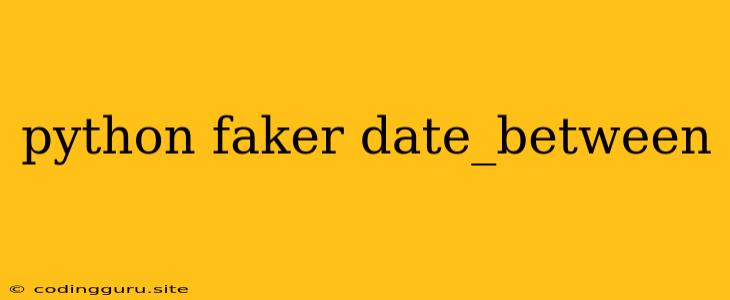Generating Realistic Dates in Python with Faker: A Comprehensive Guide
Generating realistic data is crucial for various tasks, from testing and prototyping to creating mock data for applications and simulations. Python's faker library is a powerful tool for generating random data, including dates, that closely resembles real-world information. This guide delves into the date_between function within faker, providing a comprehensive understanding of its usage and application.
What is faker and date_between?
faker is a Python library that allows you to generate realistic fake data for various purposes. It provides a wide range of methods for creating data across diverse domains, including names, addresses, emails, phone numbers, and, of course, dates. The date_between function is one such method specifically designed for generating dates within a specified range.
How does date_between work?
The date_between function takes two arguments: a starting date and an ending date. It generates a random date that falls within the specified interval, inclusive of both the start and end dates. The function leverages Python's datetime module to manipulate dates and ensure accurate date generation.
Example: Generating Dates within a Specific Range
Let's illustrate the usage of date_between with a practical example. Suppose we want to generate fake birthdates for a fictional database of users, limiting the dates to the range between January 1, 1980, and December 31, 2000.
from faker import Faker
fake = Faker()
start_date = '1980-01-01'
end_date = '2000-12-31'
for _ in range(5):
random_birthdate = fake.date_between(start_date=start_date, end_date=end_date)
print(random_birthdate)
This code snippet will output five random birthdates, each falling within the specified range.
Using date_between with Other Faker Functions
The date_between function is versatile and can be integrated with other functions within faker to create even more intricate and realistic data scenarios. For example, you can generate a list of fake employees with their respective hire dates using date_between:
from faker import Faker
fake = Faker()
for _ in range(10):
employee_name = fake.name()
hire_date = fake.date_between(start_date='2010-01-01', end_date='2023-12-31')
print(f"Employee: {employee_name}, Hire Date: {hire_date}")
Customizing the date_between Function
For more control and flexibility, you can directly manipulate the output of date_between using Python's datetime module. For instance, if you only need the year component of the generated date, you can extract it using the year attribute:
from faker import Faker
fake = Faker()
start_date = '1980-01-01'
end_date = '2000-12-31'
random_date = fake.date_between(start_date=start_date, end_date=end_date)
print(random_date.year)
Similarly, you can extract other components like the month or day as needed.
Considerations for using date_between
While date_between offers a powerful way to generate random dates, it's important to consider the following aspects:
- Date Distribution:
date_betweengenerates dates with uniform distribution within the given range. In real-world scenarios, date distributions might be non-uniform, especially when dealing with events like birthdays or anniversaries. - Leap Years:
date_betweendoes not explicitly handle leap years. To ensure accuracy, you might need to consider leap years when generating dates near February 29th. - Time Zones:
date_betweenfocuses on generating dates and does not explicitly handle time zones. If your application requires specific time zones, additional steps may be required.
Conclusion
The date_between function in faker is a valuable tool for generating realistic random dates in Python. It simplifies the process of creating mock data for various applications, from testing and prototyping to data analysis and visualization. By understanding its functionality and integrating it with other faker methods, you can effectively generate custom data sets that meet your specific requirements. Remember to consider the potential limitations and adapt your approach based on the specific context of your project.
